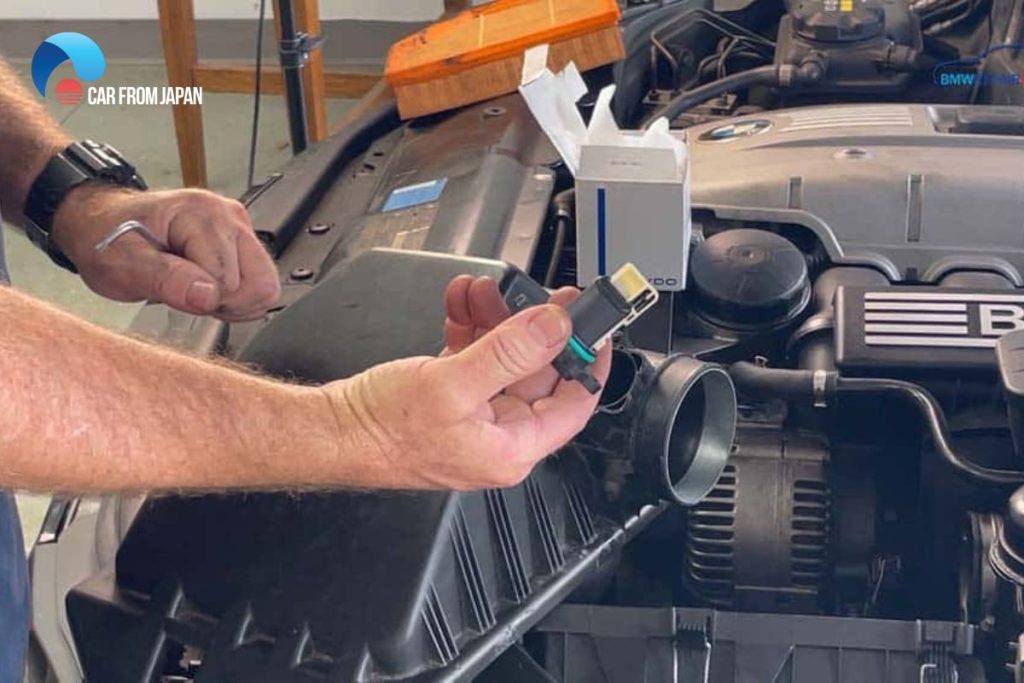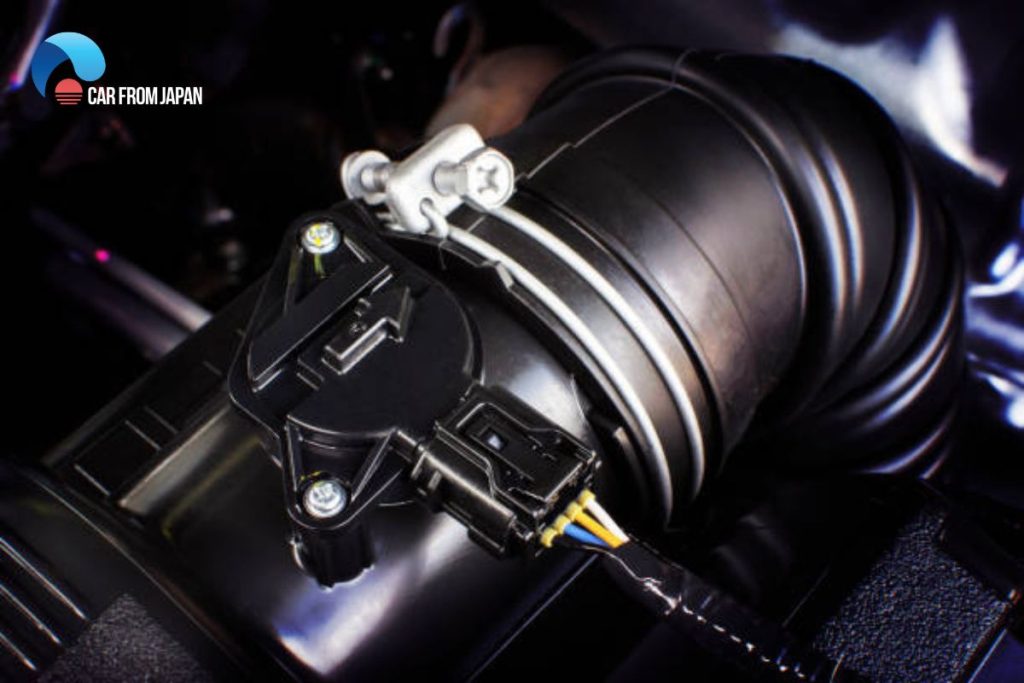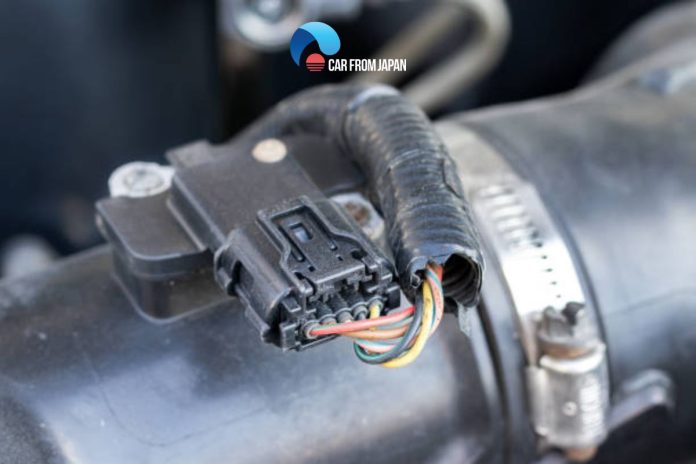Experiencing rough idling, poor performance, or black smoke from your exhaust? You might have a bad MAF sensor, the brain behind your engine’s air-fuel mixture. Many drivers think a simple replacement is all it takes, but there’s more to it than meets the eye. This article will tell you what to do after replacing mass air flow sensor – the vital before-and-after steps you need to know for a complete and successful MAF sensor replacement.
Contents
Brief Steps To Replace A Mass Air Flow Sensor
If the mass air flow sensor is severely damaged, the driver should perform the replacement steps in the sequence below:
Step 1: Open the hood and turn off your car’s ignition.
Step 2: The negative cable (red) should be disconnected to avoid danger during implementation. Locate the MAF sensor on the intake. It is commonly found in the air ducts between the intake manifold assembly and the air filter housing on your engine.
Step 3: Grab the wire harness connecting the MAF sensor and the engine compartment power unit and pull it out from the sensor. Next, you’ll gently remove the electrical connector and hose clips that hold the mass air flow sensor in place on the air intake of your vehicle.
Step 4: Replacing with a new mass air flow sensor: Compare a new sensor with the old one to make sure you have the right sensor for your car. All connections and holes must match on both parts. After checking carefully, install the new mass air flow sensor into your vehicle and then reverse the removal process to connect the wiring and hose clamps.
Step 5: Reinstall the sensor and battery connections and turn on the ignition switch. And clear the ECU memory with an OBD code reader and try to start the car again.
Do you think step 5 is the final step of this process? Not yet! When you replace any part in your vehicle, sometimes, you will expect some unwanted side effects and the MAF sensor is also no exception. You could experience some issues related to a MAF sensor even after you replaced it with a new one.

Possible Problems After Replaced Mass Air Flow Sensor
Sometimes we’ve received much feedback from our drivers that their vehicles still not work properly even with a new MAF valve. And there are common problems that you might experience after replacing a MAF sensor:
“Check engine” light is still on
We know it would be frustrating when you still notice your check engine light illuminate after replacing a MAF sensor. You already knew a MAF sensor may be responsible for the performance and the circuit trouble codes.
However, fuel trim and misfire codes can also be connected to them. It means that as soon as a MAF sensor is going bad, other sensors mounted around the engine will immediately detect and send a warning to the central control unit.
Flat spot on acceleration
When you finish the MAF sensor replacement, if you still have difficulty accelerating in highway traffic or while passing, it means that your ECM could be limiting injection due to a new MAF sensor issue.
Rough idle
It’s not rare when you notice your engine not idling properly or running a little rough after replacement. The reason is that maybe your new MAF sensor has some problems. Without the right amount of fuel, it’s hard to get a smooth idle.
At this time, the amount of air supplied to the engine compartment is unstable, causing the mixture to burn inside the cylinders in excess and in short supply, directly affecting the engine’s performance. Your engine might not start smoothly if the MAF sensors don’t work properly, especially when idling.
Why Do The Problems Still Arise After Replacing An Old MAF Sensor?
These problems make drivers worried because they don’t even know what the reasons are. This problem occurs due to some possible causes:
Improper Installation
A faulty installation is one of the most common reasons that cause your vehicle to not work properly after replacing a new MAF sensor. As we know, the MAF sensor replacement process is quite complicated.
So when we do this process at home, we often will experience some errors in the replacement process such as missing steps or doing the wrong process. And the result is that the new MAF sensor will lose its function.
Forget resetting the ECU
Not resetting your car’s computer is the second thing you’re easy to forget when changing a MAF sensor. As we know, a MAF sensor will collect related information to select the exact amount of fuel and then transfer this data to your Engine Control Unit (ECU).
The ECU operates and provides the engine with the correct amount of fuel. If you do not reset the ECU, the codes from the sensor will not be synchronized with the computer at this time.
The codes will help mechanics diagnose problems with the mass air flow sensor. Therefore, when some codes are out of sync with the ECU, you will see some problems like checking engine light is on, or your car is not working smoothly…
Having a wrong new MAF sensor
Buying the wrong sensor is the most common reason that many drivers experience when replacing the sensor on the vehicle. The MAF sensor sends the signal to the ECU about how much air is entering your engine.
Actually, some different types of sensors have the same functions as MAP or airflow sensors that use moving flaps (older model). This is the reason why you couldn’t simply change your old type of sensor with another brand or from one manufacturer with a sensor from another, or even if these sensors are the same type.

What To Do After Replacing Mass Air Flow Sensor?
Our last mission when replacing the bad MAF sensor is that this sensor will be recognized by your engine. However, in some ways, problems could still arise after the replacement process, all of which can be prevented if you take some simple but important steps after replacing the MAF sensor:
Disconnect your car battery
When you finish installing the mass air flow sensor, the process is not over yet. Instead, it needs some extra steps to completely replace it. And disconnecting your battery for around 10 to 15 minutes is strongly recommended.
The purpose of this step is to help the car ECU have enough time to reset and remove the old information and update the new setting to record the new parameter with the new replacement. Not all vehicles can automatically reset the error code if you disconnect the battery for several minutes, so you need to try this step to make sure your MAF valve operates smoothly.
When connecting your battery, the ECU will start loading every bit of information related to the new MAF sensor. When the battery is removed, it should not cause any problems.
Make sure the proper replacement
If you make the MAF sensor replacement at home, let’s ensure you follow the instructions correctly. Improperly installed MAF results in faulty readings that cause the ECU to send the not incorrect amounts of fuel to your engine.
Furthermore, the consequence can be an incorrect air-fuel mixture, causing rough idling. There are some notes you should consider when replacing your new MAF sensor:
- When receiving a new MAF sensor, you should notice the type of connections and ensure that you have the proper tools in place to disconnect and reconnect the sensor to the intake manifold and the airbox.
- Double-check all of the steps you did to make sure you don’t leave anything out and that it gets done efficiently.
- During the replacement of the MAF sensor, you should take care not to touch the sensing element inside the MAF sensor. This element is very fragile and is often exposed during sensor removal.
- Make sure that you have the correct MAF sensor. Read the number on the old sensor carefully and compare it with the OE number in the description. of your new sensor. Usually, the description will show the Initial number, OE number, or reference number.
- It is often necessary to have a road test for other sensors on the engine to recalibrate. In some situations, it has to reset the dormant facility or other parameters using the relevant diagnostic tool
Resetting the ECU
Resetting ECU means removing all the memory of your car’s computer to get rid of all the errors and errors in the settings. In most modern models, the ECU, and ECM will automatically reprogram after replacing the MAF sensor.
But in some old models, this is not possible so you need to reset the ECU. It is the most effective way to handle the problems when replacing the new MAF sensor. Recalibrating the ECU sometimes requires some technicalities, which will depend on your type of vehicle.
You can reset the ECU based on 2 ways: Removing your car battery (modern vehicles) or by using an auto scanner (OBDII scanner).
FAQs
Why is it important to replace a faulty MAF sensor?
A faulty MAF sensor can lead to a range of problems, including poor fuel economy, rough idling, reduced engine power, and increased emissions. Replacing it ensures your engine receives the correct air-fuel mixture for optimal performance.
Can I drive my car with a bad MAF sensor?
While you might be able to drive short distances, it’s not recommended. A faulty MAF sensor can cause significant engine problems over time, leading to more costly repairs.
How often should I replace my MAF sensor?
A Mass Air Flow (MAF) sensor typically lasts between 80,000 and 150,000 miles, but proper maintenance and cleaning can help prolong its life. However, if you experience consistent issues, even after cleaning, it may be time to replace the sensor.
Cost for mass air flow sensor replacement: How much?
The average cost for mass air sensor replacement is $452 to $524, depending on the make and model of the vehicle. Enter your vehicle’s information to see how much mass air sensor replacement costs in your local area.
Final Thoughts
When a mass air flow sensor is faulty, at that time it cannot accurately move airflow into your engine, making the ECU miscalculate the amount of fuel injection. It causes some problems: stalling, rough idling, and poor acceleration. Understanding the importance of this sensor, anytime you replace it. Make sure you follow the procedures and steps to help your car reach the best performance.



